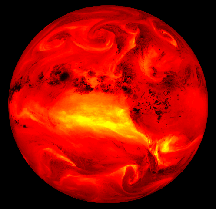Although short-lived in the atmosphere,
aerosols have the theoretical possibility to cool the atmosphere
and are sometimes referred to as 'anti-greenhouse gas. Estimates
of both their magnitude and importance vary from a relatively
small influence to one which, in the Northern Hemisphere, can
counter the entire greenhouse forcing up to the present.
One of the first steps in considering the
impact of anthropogenic sulfates is the development of an accurate
regional emission inventory of sulfur as a function of time.
There have been several attempts to identify trends of sulfur
dioxide emissions for the period since the middle 1800s. Large
discrepancies among the approximations reflect the many uncertainties
associated with estimating the sulfur estimates. Besides global
determinations, continental or national estimates of sulfur emissions
have been made.
Beginning in September 1994, under a grant
from the U.S. Department of Energy, A.S.L. & Associates and
its subcontractor, CAPITA at Washington University St. Louis,
and consultant Dr. Peter Brimblecombe combined talents to develop
a database that allows for the estimation of the global emissions
of sulfur from 1850 to 1990. A common methodology was applied
across all years and countries for the estimation of sulfur emissions.
In all cases, the emission estimates for each country are based
on the production, percent sulfur, and sulfur retention information
associated with that country's activities. If data were available,
such as United States emission estimates from the U.S. Environmental
Protection Agency, the information was used only for purposes
of comparison with the estimate results derived from this research
effort.
Temporal resolution information is available
from the database; thus, changes associated with specific historical
events (e.g., wars, internal reorganizations, etc.) are clearly
observed in the emissions inventory on a national, regional,
or global basis. Some of the important uses of ASL/CAPITA global
sulfur emission inventory are to serve as (1) input into global
pollution models; (2) a way to compare the global sulfur emission
patterns to atmospheric sulfur concentration data; and (3) the
basis for global sulfur emission projections. This research effort
attempts to correct some of the deficiencies associated with
previous global sulfur emissions by (1) identifying those production
activities that resulted in sulfur emissions by country and (2)
calculating historical emission trends by country across years.
Emission estimates derived from this research effort have been
compared with previous estimates to put into perspective how
well the sulfur estimates in the ASL/CAPITA data based for each
country compared with the previously used methods. Our estimate
for global sulfur emissions from 1850 to 1990 is available.
The database is available. We suggest that
you order the A.S.L. & Associates report from the
National Technical Information Service (NTIS) of the U.S. Department
of Commerce. The report provides the detailed information on
how the database was created. To purchase a copy of the peer-reviewed
U.S. Department of Energy Report, please refer to it as NTIS
Order Number DE96014790INZ. The NTIS sales desk staff is available
between 0830 and 1700, U.S. eastern time at 703-487-4650. The
mailing address is NTIS, 5285 Port Royal Road, Springfield, VA
22161. Fax orders can be made at 703-321-8547. To verify receipt
of a fax, please call 703-487-4679. The database
can be accessed. Please note that a paper appeared describing
our research effort and summarizing our findings in the peer-reviewed
journal, Atmospheric Environment. The citation for this
paper can be found in our publication
section.
